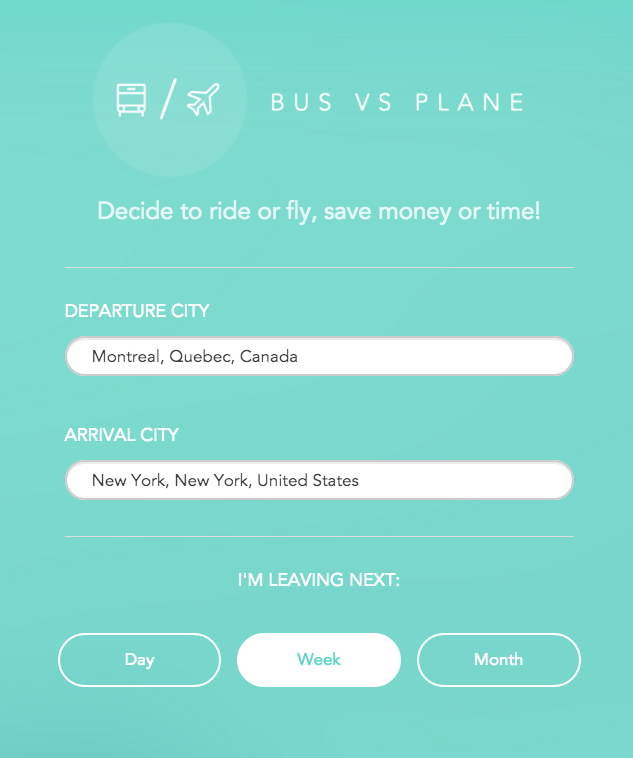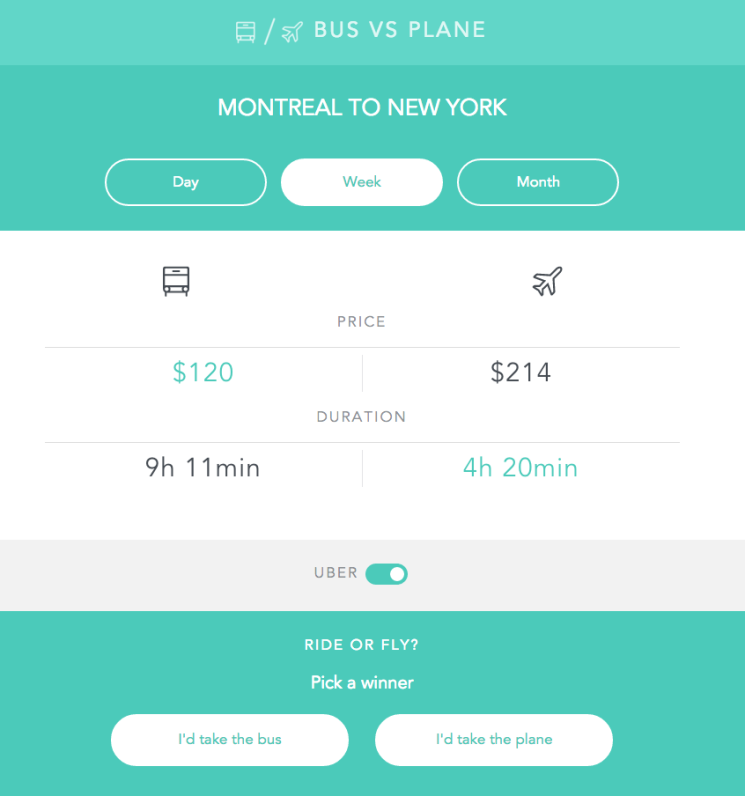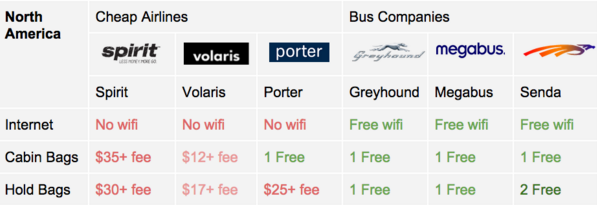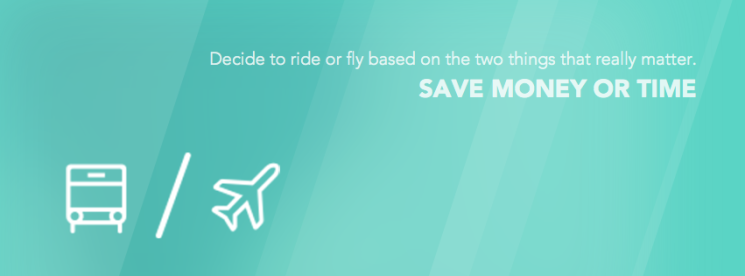Should I use the bus or should I travel by plane? That is a question that a lot of folks ask themselves whenever they have to travel. There are a lot of variables that come into play but it usually comes down to two things: price vs. time. How much time will I be saving by choosing to fly? How much money will I save by opting for the bus?
Because of market fragmentation, bus travel is probably the most technically challenging transportation mode to aggregate and standardize. We looked into flights data for fun and realized that we could build a very basic comparator in a couple days by using Google Flights’ QPX Express API. And we did it!
Today we’re proud to introduce Bus vs Plane, a web-based app that allows travelers to easily compare bus and plane trips on price and duration.
The tool is quite simple to use: simply enter your origin city, destination and when you plan on taking the trip in the search box.

Bus vs Plane gives you an intuitive side by side comparison of the two traveling options. You can also decide to include the cost and time associated with taking an Uber to your local airport or bus terminal from the corresponding downtown area.

At Busbud, we spend our days working hard to get you the best bus ticket value, but sometimes, taking a flight, a train or sharing a ride might be a better option for you, and that’s why we built this app.
Built in 2 days, polished in a few weeks
Busbud holds regular hackathons where our team splits into small groups to work on cool ideas (like our amazing Pong Dome or the Dollar Bus Club).
We know there’s a growing number of people who cross-over between taking super cheap flights and the even cheaper buses on certain routes. This is happening all across North America, Europe and other parts of the world where ultra low-cost airlines like Spirit, Volaris and Wizz Air are gaining traction, while bus companies like Greyhound, Megabus, OUIBUS and Flixbus are adopting very competitive dynamic pricing models.
We wanted to make choosing the travel mode easier for these multi-modal users and decided to build busvsplane.com, that would allow them to quickly see which mode is worth looking at, or if both are. Bonus point: the domain name was available.

Bus vs Plane initial sketch
With the rise of dirt cheap airlines and $1 bus tickets, it’s tough to keep tabs on your options for every route and figuring out which method is best for you. Since budget conscious customers obviously care about the price, we looked at that. We also looked at travel time because that’s the other biggest difference between these two modes of transportation and the main factor in deciding if the user goes with the cheaper option or not.
So we built a tool that shows just that: the lower price and shorter travel time on a route. We did our best to illustrate this so users can decide which mode or both are worth looking into for their trip.
Three advance-purchase time frames
We all know buying a flight in advance can save you money. The same this applies to most buses, too. We wanted to simplify things and avoid forcing the user to select a date from a calendar. We set up three scenarios for comparing your options: booking one day in advance, one week in advance and one month in advance of travel.
How we calculate price and duration
For flights, we used Google Flights’ QPX Express API to pull data on flight duration and prices for each of the advance purchase periods. Flight data is complicated, once you add a bunch of stopovers and high priced flexible tickets, we’re pretty sure even the wealthiest corporate clients never buy, so we filter the results down to 120% of the duration of the shortest flight time.
If the duration of the quickest flight (usually a direct one) is 5 hours, we’ll look at all the flights under 6 hours. This means some super cheap, out of the way flights with two extra stop overs probably won’t be shown, but we’re sure to show air travel’s speed advantage. Out of the flights in the bracket we display the price and the duration for the cheapest flight. We think this is more or less how a regular user would proceed.
Unfortunately, QPX Express API is not returning results for all the airlines you can find on Google Flights. For example, Delta and American Airline’s data requires specific approval by these carriers. And we noticed some european low cost airlines were also missing. But we’re planning to switch from QPX Express to a more comprehensive API for the next iteration of the tool.
There’s still a hurdle for getting live data on intercity buses, because while we’re building a centralized system for this data at Busbud, we can’t harvest so much data that we make the bus companies’ systems crash. We work around this by tapping Busbud’s last month of searches and simply look at average prices and durations for buses in each booking period (1 day, 7 days, 30 days). We went with averages since the data set is still relatively limited and it’ll help us avoid showing outliers (good and bad) that the user isn’t really that likely to encounter when they go to book a ticket (like the $1 tickets).
The comparability isn’t perfectly 1:1 yet, since the plane data is only looking ahead and the bus data is looking back, plus the bus price estimates are a bit more conservative because they’re averages rather than minimums, but it provides a pretty good idea of what prices look like and what the majority of people will end up paying.
Going to the airport or to the bus station
We also add the Uber fare and driving time (for UberX, UberPop or whatever the cheapest class Uber provides pulling from their API is) from the city center as found by Google Maps to the airport and bus station respectively. For flights, we also add the optimized 90 minute buffer for arriving at the airport, while for buses we add 10 minutes before departure since we know that’s when passengers commonly arrive for their bus.
Other fees
There are some factors we can’t take into account. One of them is baggage fees.
Because there isn’t standard data for this across airlines or buses, we weren’t able to capture this. In summary, bus companies tend to allow more bags and don’t charge as many fees. Megabus USA seems to be the strictest amongst the bus operators with one free piece of carry-on hand luggage and one free hold bag, while some the cheapest budget airlines even charge a fee for carrying on cabin baggage, that’s bigger than a purse. Buses will let you bring your own snacks; hell, some bus companies even allow BYOB. (We’re looking at you, Germany. Prost!)


Comfort factors
Besides the price and time, there are comfort factors. For instance Wi-Fi. Bus companies are pretty generous with providing free Wi-Fi. Airlines are pretty stingy with the Wi-Fi, especially on the super cheap airlines that this tool tends to find. You might Wi-Fi on the more upscale airlines, but for a fee:
Delta, United, American, Southwest, Lufthansa: No free Wi-Fi, paid Wi-Fi is available on some flights.
Air France and KLM: A very small amount of their planes even have Wi-Fi.
easyJet: Nope, no wifi except on some test flights.
At Busbud, we want to help our users find the best way to get from point A to point B. We won’t advocate for the bus if it’s cheaper, faster and more convenient to catch a flight. If you want to go from Lima to Cusco, you might want to save 18 hours and fly across the Andes. Unless you want to gaze at the jaw-dropping Peruvian landscapes for almost a full day 🙂

Check it out for yourself at busvsplane.com, let us know how it goes and send us the craziest differences in price and time you can find!
